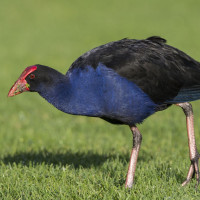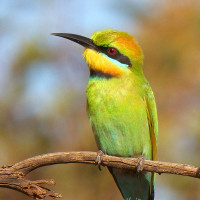Opis
Herdsman Lake Regional Park is a reed-fringed lake and paperbark swamp in the heart of Perth’s metropolitan area. Waterbirds and migratory birds come here to breed and enjoy a summer refuge. You can watch them wading among the rushes, paperbarks and flooded gum trees. The abundant waterbirds include 8-9 species of ducks, plus cormorants, grebes, egrets, ibis, herons, cockatoos and lorikeets.
Star attractions include Great Crested Grebe (several breeding pairs every spring), Rainbow Bee-eater (they breed at Herdsman and are typically present from late September to mid-February), Freckled Duck (some years there are only few), Blue-billed Duck (present year-round, highest numbers through autumn and early winter), Nankeen Night-Heron (usually roosting in the paperbarks around the wildlife centre) and Glossy Ibis. Over 160 species have been recorded on eBird. The Herdsman Lake Wildlife Centre (has coffee!) on site.
Szczegóły
Dostęp
Herdsman lake is located only six kilometres from the city centre of Perth. Easy access by car, bus or cycling. You can park near the Herdsman Lake Wildlife Centre. Click on the P in the map for directions or coordinates. From there you can walk the Herdsman Loop, an eight kilometre trail around the lake. You can stay on the cycle path or divert through woodland dirt tracks around the lake. Make sure you include the Olive Seymour Boardwalk on your circuit where you walk among the Paperbark trees. The Herdsman Lake Wildlife Centre provides an opportunity to interact with conservation research activities conducted at the site. Activities run by the centre include bird walks, information nights and wildlife excursions.
If you don't feel like walking the entire track you can walk shorter sections starting from Popeye lake (north end), which are about 3 kilometres.
Teren i siedlisko
Tereny podmokłeWarunki
Płaski , BagiennyTrasa dookoła
TakCzy luneta będzie przydatna ?
NieUdany sezon obserwacyjny
Przez cały rokNajlepszy czas na wizytę
Wiosenne migracje , Jesienne migracjeTrasa
Szeroka ścieżkaPoziom trudności szlaku pieszego
ŁatwyDostępne
PieszoCzatownia/platforma obserwacyjna
TakLinki
- Exploreparks.dbca.wa.gov.au on Herdsman Lake
- Birding Blog on Herdsman Lake
- Ebird hotspot
- Bushlandperth.org.au on Herdsman Lake


